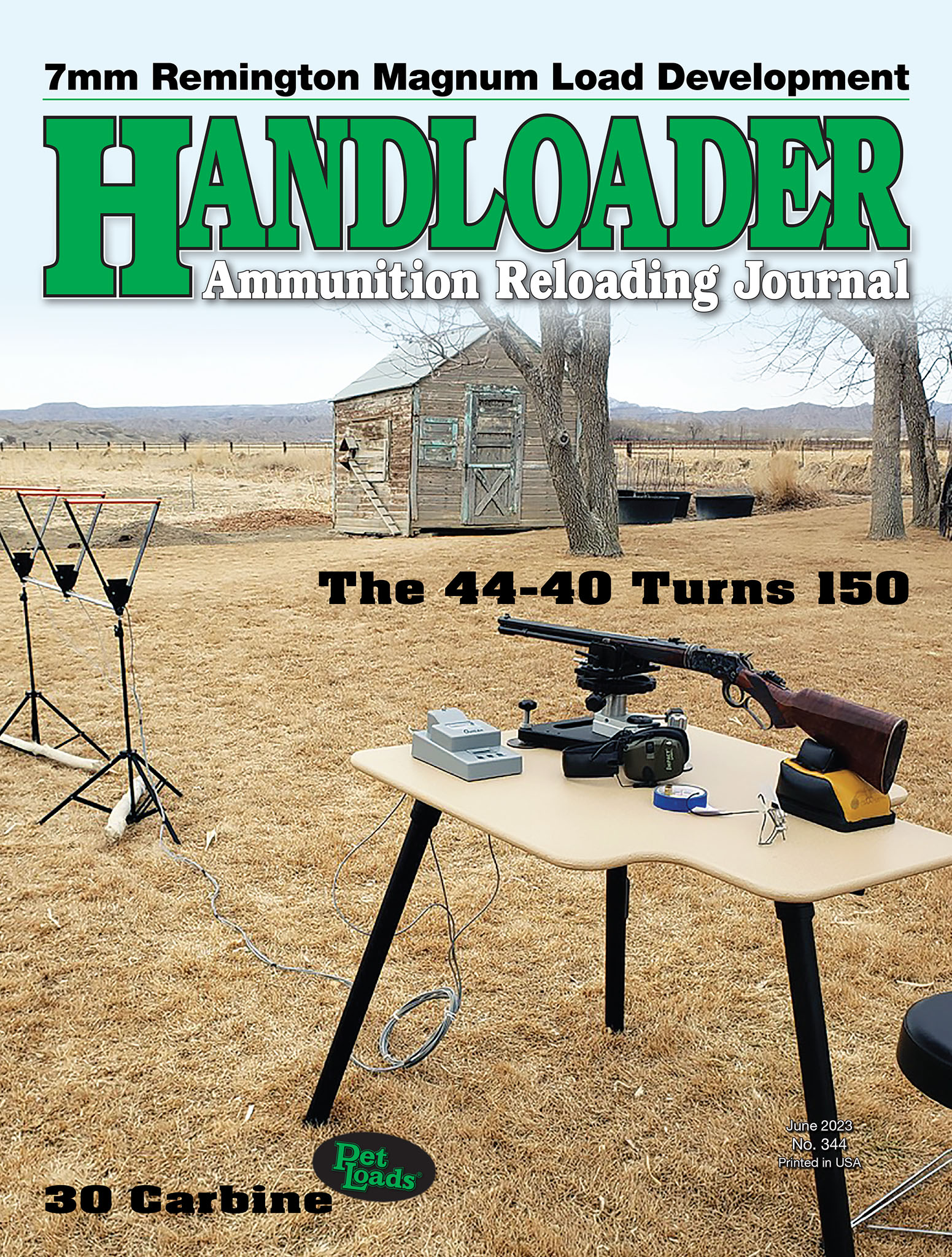
The Universal Firearms Model 1001 Military chambered in 30 Carbine (bottom) is similar in design to the original U.S. M1 Carbine (top), but there are distinct changes in the design.
The U.S. M1 Carbine chambered in 30 Carbine is a unique fighting rifle that was originally conceived by the U.S. Government as a defensive weapon for radio operators, truck drivers, engineers, artillerymen and officers who found the 10-plus pound M1 Garand rifle too heavy and inconvenient to carry during daily responsibilities, but still needed for a weapon. The “light rifle” project technically began in 1938, but the formal requirement was not finalized until 1940.

An original U.S. M1 Carbine (left) manufactured in 1943 by Inland, a division of General Motors, was used to develop “Pet Loads” data, while a Universal Firearms Model 1001 Military (right) was used to cross-reference function.
The first Army testing was in August 1941, but more work was necessary. Testing of the second prototype occurred in September 1941, which beat out all competing rifles and was approved on October 22, 1941. This Winchester rifle and cartridge development was officially known as the “United States Carbine, Caliber .30, M1.” This combination served the U.S. military through 1973 (although the military began formally abandoning it in 1957); during that time, it saw extensive use in many wars and conflicts. Interestingly, it remains in service today in many foreign countries. Amazingly, there were more than six million guns produced during World War II for military applications and production continued by Plainfield Manufacturing after the war for commercial sales. Today, there are a number of reproductions (of varying quality) offered commercially. Yes, the 30 Carbine cartridge is alive and well!
Contrary to popular belief, the M1 Carbine was not supposed to replace the 1911 45 ACP pistol, rather, it was conceived as a defensive weapon with greater range and firepower. It initially featured 15-round capacity box magazines, but 30-round versions were soon offered. Military brass specified that the rifle should weigh less than 5 pounds, be of at least 27 caliber and have an effective range of 300 yards or greater. It seems that Germany was making it a habit to use paratroopers to launch “blitzkrieg” attacks behind the front lines. Armed with a fast-handling, lightweight carbine, support troops could effectively combat these forces, but the little carbines proved useful in many other military applications wherein a defensive arm was needed that offered greater range than the 1911 45-caliber pistol. The M2 Carbine was introduced toward the end of World War II and featured a select-fire switch for optional full-auto fire, while the M3 likewise featured select fire, but was equipped with an infrared scope system.

Winchester was the primary designer of both the U.S. M1 Carbine and the 30 Carbine cartridge, and they produced considerable ammunition for wartime needs.
Military guns were produced by a staggering 12 different companies, with some variants and versions being popular with collectors. In other words, if shooting an original military rifle, it may be worth researching its value before shooting it in high volume. The barrel length was listed as being 17.75 inches, but the length is often incorrectly stated as being 18 inches, which seems to be a more common length associated with reproductions. The action features twin forward-locking lugs, a rotating bolt and a gas-operated, short-stroke piston system. It may resemble a scaled-down M1 Garand at a glance, but it has notably different design features. Engineers behind the project included Edwin Pugsley, William C. Roemer, Fred Humeston, Cliff Warner, Marshall “Carbine” Williams and multiple unnamed Winchester engineers. It should be noted that Carbine Williams, an employee at Winchester, certainly had some input and contributed to the final design of the M1 Carbine, but his involvement was somewhat minimal. Williams had previously developed the patented short-stroke gas system and continued work on a different system that was not used in the M1’s final design. But Williams became famously associated with the M1 Carbine due to the 1952 movie “Carbine Williams,” starring James Stewart, which in typical Hollywood fashion inaccurately portrayed facts, but I digress.

“U.S. CARBINE CAL. 30 M1” receiver marking.
The 30 Carbine cartridge was developed as an integral part of the M1 Carbine project. It is based on the old 32 Winchester Self-Loading cartridge, but it is rimless and loaded to higher pressures. Interestingly, one report indicated that the first 100,000 rounds of 30 Carbine ammunition was headstamped with “.30 SL.” Many sources list the ballistics of the M1 Ball load with a 110-grain bullet at around 1,990 feet per second (fps), but those are commercial ammunition velocities. Early military loads listed a 111-grain bullet at 1,860 fps, but that was soon changed to a 110-grain full metal jacket bullet with a muzzle velocity of 1,900 fps with a 30 fps plus or minus. The primers used were always non-corrosive, while most other U.S. military cartridges featured corrosive priming into the late 1950s, which explains why most M1 Carbine bores do not show corrosion. It is noteworthy that the military also used loads that included the M6 (grenade), M13 (dummy), M18 (heavy, high- pressure test) and the M27 (tracer). During the 1950s and 1960s, surplus ammunition became plentiful and very inexpensive. In spite of huge quantities of M1 Carbines sold as surplus to civilians for $20, gunmakers were still compelled to offer newly manufactured rifles such as Universal Firearms, Auto-Ordinance, MKS Supply, Alpine Industries, Iver Johnson and Bullseye Gun Works, but I came up with a (probably incomplete) list of other rifles that easily exceeded 20 models and manufacturers. Even handgun manufacturers offered guns including Plainfield Machine that was eventually sold to Iver Johnson, but there are more conventional handguns including the Ruger Blackhawk, AMT AutoMag II, Thompson/Center Arms Contender and Taurus Raging Thirty, but pet loads for those guns will have to wait for another day.

The pressures and velocities of the 30 Carbine have changed little over the past 80 years. These vintage Winchester military loads date back to 1944.
Today, surplus loads are scarce with sporadic availability, but Federal Cartridge, Remington and Winchester Ammunition each offer commercial loads containing 110-grain, full metal jacket and softpoint loads listed at 1,990 fps, while Hornady Manufacturing lists a 110-grain FTX bullet at 2,000 fps. These loads generally work in vintage and reproduction rifles with high reliability and if the bore is in reasonable condition, produce close to their listed velocities.

“INLAND MFG GENERAL MOTORS 4-43” barrel marking.
For today’s test rifle, an original Inland Carbine, which was a division of General Motors and is so marked on the barrel, was selected. This sample gun was manufactured in 1943 and although it shows external wear and use, it is mechanically good. In measuring the bore, it shows that there is only modest wear and with the aid of a Lyman borescope, the throat was examined and it showed very little wear or erosion. Initial shooting (from sandbag rests with targets at 75 yards) showed that accuracy was also up to par, which I will discuss momentarily. This Inland Carbine would make a good test vehicle for developing pet loads. A second rifle, a Universal Firearms Model 1001 Military with an 18-inch barrel, was used primarily to cross-reference handloads for function testing.
Ballistics and maximum average pressure guidelines for the 30 Carbine have been largely unchanged since soon after its development more than 80 years ago. Currently, the Sporting Arms and Ammunition Manufacturers’ Institute (SAAMI) lists maximum pressures at 40,000 psi or 40,000 CUP, which is a bit unusual for both CUP and psi measurements to share the same figure, but that does occur occasionally with some cartridges. All of the accompanying handload data is within industry pressure guidelines.

By the length and design nature of the M1 Carbine action, overall cartridge lengths should be adhered to and bullet nose profiles should generally be roundnose designs although some hollowpoint bullets will feed fine.
The 30 Carbine features a straight-tapered case, which serves to aid with easy extraction. When handloading new cases, or reloading previously-fired cases, they should always be full-length sized to assure that cartridges will readily chamber. Due to the tapered case, most sizing dies are steel and cases will need lube. However, RCBS and Lee Precision offer carbide die sets (at a higher cost when compared with other carbide dies due to the rather long length of the carbide ring insert), which usually eliminates the need to lube cases. Incidentally, Lee sells just the carbide sizer die if handloaders want to upgrade an existing set of steel dies. A carbide die is a significant time saver and is well worth the investment.

The maximum overall cartridge length for the 30 Carbine is 1.680 inches.
Under normal supply and demand (whatever that may be in the firearms industry), new 30 Carbine empty cases are available from Winchester, Remington and others; however, they have been largely unavailable for the past several years. Starline now offers new cases, which were used to develop the accompanying data and are available factory direct. Cases were first full-length sized, then checked for proper length. The 30 Carbine headspaces off the case mouth, so the case length should measure 1.290 inches maximum and 1.285 inches minimum to obtain proper headspace control. Incidentally, cases shorter than the suggested minimum length can cause misfires.

The 30 Carbine headspaces on the case mouth, so a taper crimp should be used with most military cartridges measuring .333 inch at the case mouth.
Small rifle standard primers are generally used with the 30 Carbine, which offers plenty of ignition heat or energy for the comparatively small powder charge. Small rifle primers offer plenty of strength to easily handle the 40,000 psi/CUP pressures associated with maximum loads. CCI BR-4 primers were used to develop the accompanying data, which were seated .003 to .005 inch below flush per SAAMI specifications.

The 30 Carbine (left) is similar in size to the 32-20 Winchester (right).
The 30 Carbine thrives on powders with a burn rate that typically falls between Alliant 2400 and Hodgdon H-110, both of which performed very well in terms of accuracy, but also produced typical velocities of 1,900 to 2,000 fps using various 110-grain bullets. The original powder used in military loads for the 30 Carbine was Winchester Powder No. WC820, that more or less shares the same formula and burn rate as today’s modern Accurate No. 9. To be clear, No. 9 was first produced by IMI in Israel around 1979, then production was moved to the Czech Republic, but after Western Powders acquired Accurate Arms Powders, manufacturing was changed to the U.S.-based St. Marks powder (a subsidiary of General Dynamics) where it remains today. Regardless of where produced, the burn rate and formula remains largely unchanged and is the same as the above mentioned Winchester WC820 powder used during World War II. However, the St. Marks version has the tightest specifications, or the least amount of variance from one lot number to the next, which is a huge benefit to handloaders that use canister-grade powders. Regardless, No. 9 remains a top choice for handloading the 30 Carbine and performed extremely well in my tests. Other notable powders included Vihtavuori N110, Winchester 296 (exactly the same powder as Hodgdon H-110), IMR-4227, Accurate No. 11FS, A-1680 and Ramshot Enforcer. Regarding cast bullet loads, 2400 and IMR-4227 were selected, with both giving respectable results.
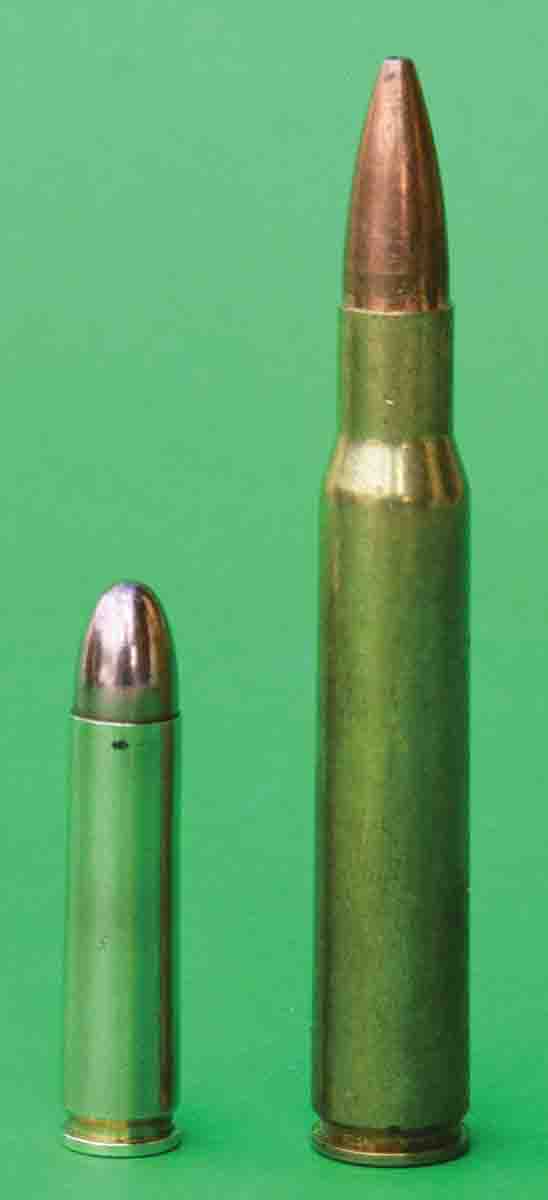
The 30 Carbine (left) was notably smaller than the 30-06 (right). Rifles were also less than half the weight, which were much easier for military support personnel to carry on a daily basisfor defensive purposes, but still have greater effective range when compared to the Model 1911 45 ACP.
The 30 Carbine has a fairly small window so to speak regarding bullet weights, bullet profile, velocity and pressure in order for it to achieve proper function. The most reliable loads will feature 110-grain roundnose bullets, in either softpoint of full-metal-jacket construction. Generally speaking loads will usually generate around 32,000 to 40,000 psi/CUP pressure and reach 1,750 to around 2,000 fps, while cartridges will have an overall length of 1.640 to 1.680 inches.
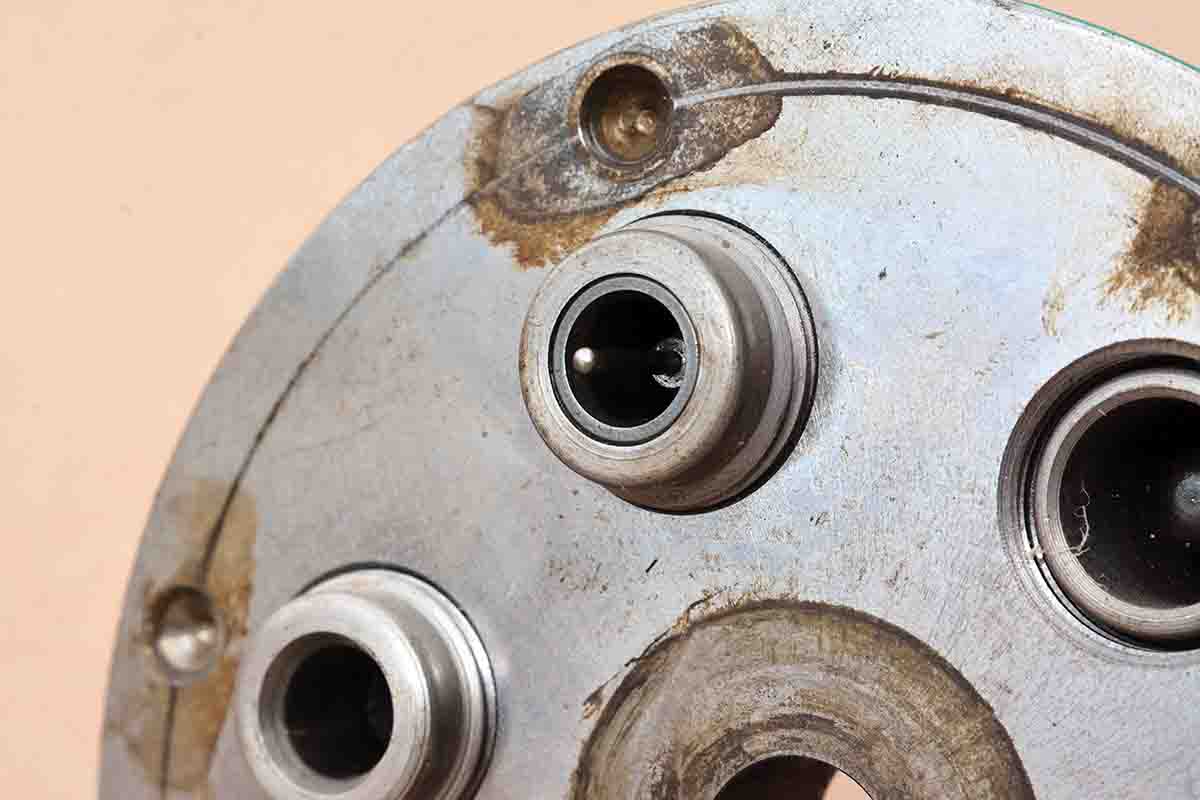
The 30 Carbine is a straight-tapered case. Steel sizing dies will require case lube, but RCBS and Lee Precision offer carbide dies that eliminate the need to lube cases.
Hornady, Sierra and Speer each offer roundnose profile bullets designed specifically for the 30 Carbine. Hornady offers both a 110-grain full metal jacket and roundnose with softpoint, but they also offer a 100-grain short jacket and a 90-grain XTP. All Hornady bullets fed and cycled without a single failure. Sierra offers the 110-grain Pro Hunter roundnose softpoint that likewise worked perfectly and gave top-notch accuracy. Incidentally, the Hornady and Sierra softpoint bullets are designed to readily expand at velocities of 2,000 fps or less, which make them viable choices for hunting appropriate-sized game and protection. Speer offers their electrochemically-plated, 110-grain total metal jacket bullet that is relatively inexpensive and produced perfect reliability in both test rifles. They also offer a half-jacket, 100-grain Plinker that offers expansion. Another Speer bullet that has become very popular in 30 Carbines includes the 110-grain Varminter hollowpoint. This bullet offers impressive expansion qualities, but some rifles will not always feed this bullet with 100 percent reliability. However, in developing loads with the Speer Varminter and testing them in both rifles, the function was perfect.
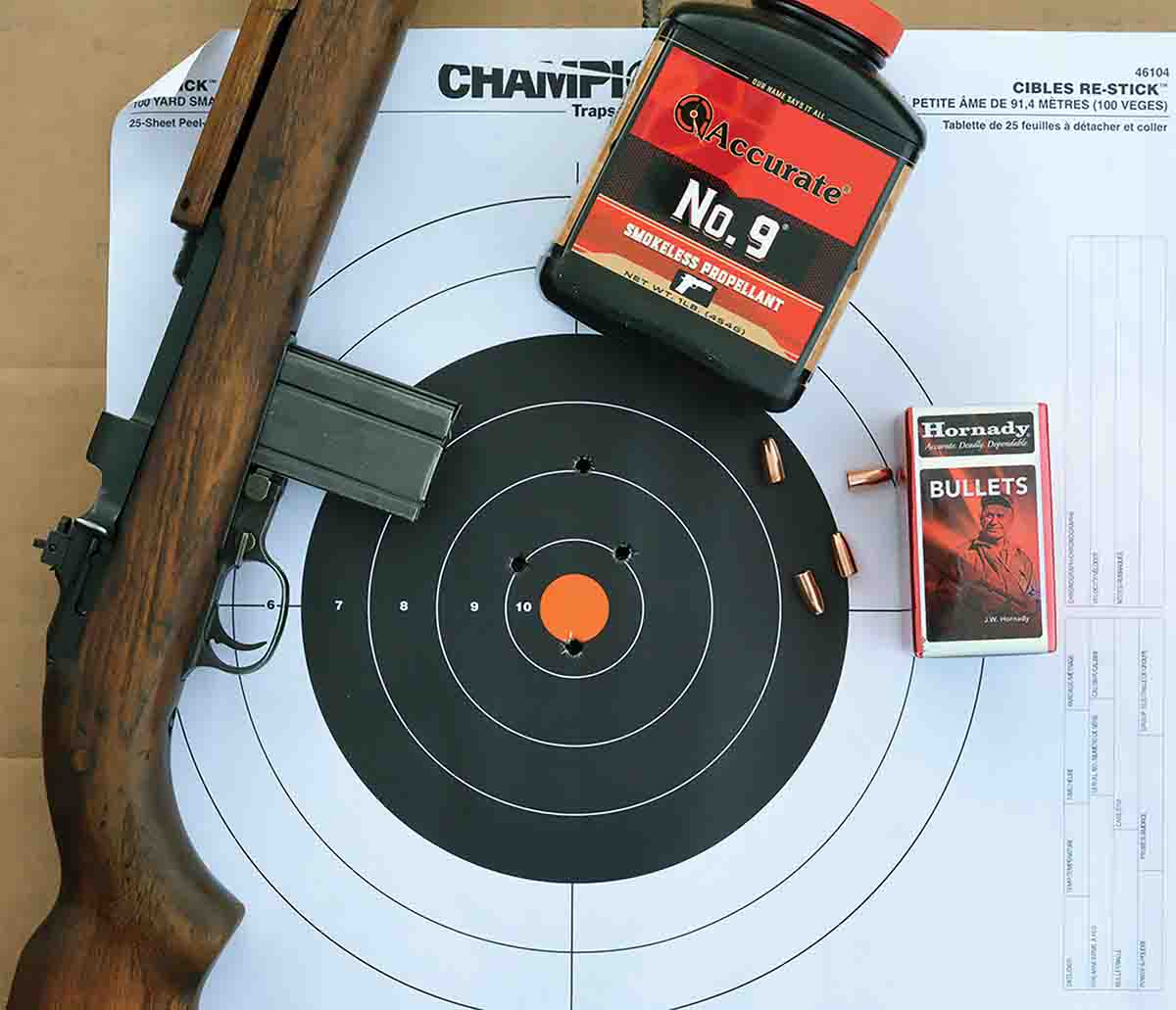
The M1 Carbine is not known for outstanding accuracy, but if the bore is in reasonable condition and the action is properly bedded within the stock, along with quality handloads, 3-inch groups at 100 yards are often possible.
Cast bullets are also a viable choice for the 30 Carbine, as they cost less, can produce good accuracy and produce little barrel wear. Lyman mould No. 311410 was chosen, which is a roundnose profile with a plain base and has a listed weight of 130 grains. However, test bullets were cast hard with a BHN close to 20 and the actual weight was 124 to 125 grains. Another great cast bullet is the Redding/SAECO No. 302, which is a roundnose design with a gas check and weighs 117 grains. It gave good accuracy in the test rifles, but with some additional load development it is expected to produce even tighter groups.
After bullets are seated to their correct overall cartridge length, they were crimped using a taper crimp die as a separate step. SAAMI specifications list the crimp at .336 inch, however, 1944-era Winchester military loads measured .333 inch. In my own testing, a crimp of .334 inch seemed to offer enough pull to prevent bullets from deep seating, yet still allowed the case mouth to offer positive headspace control. Tests also indicated that this heavier crimp lowered extreme spreads.
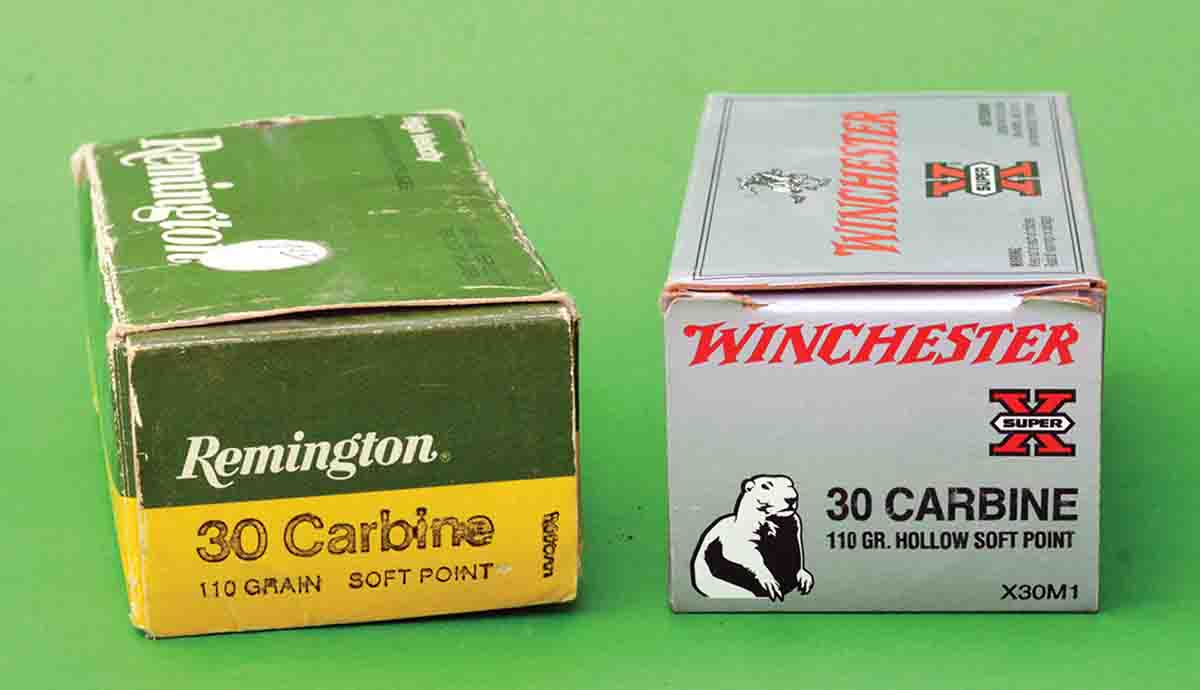
Remington and Winchester list commercial 30 Carbine ammunition with a 110-grain bullet at 1,990 fps.
Regarding accuracy; during my teenage years, it seemed like surplus M1 Carbines were everywhere. It was often the consensus among owners that they were not accurate and I often heard that they would only group into “about a foot at 100 yards.” That might have been true, but many of those guns had fired many thousands of rounds in the service and many civilian owners burned through the inexpensive surplus ammunition until the forearm wood was literally smoking! In many instances, the bores were worn excessively. Another factor was that after their service life, many of the rifles had mismatched stocks installed that were not properly fit or bedded.
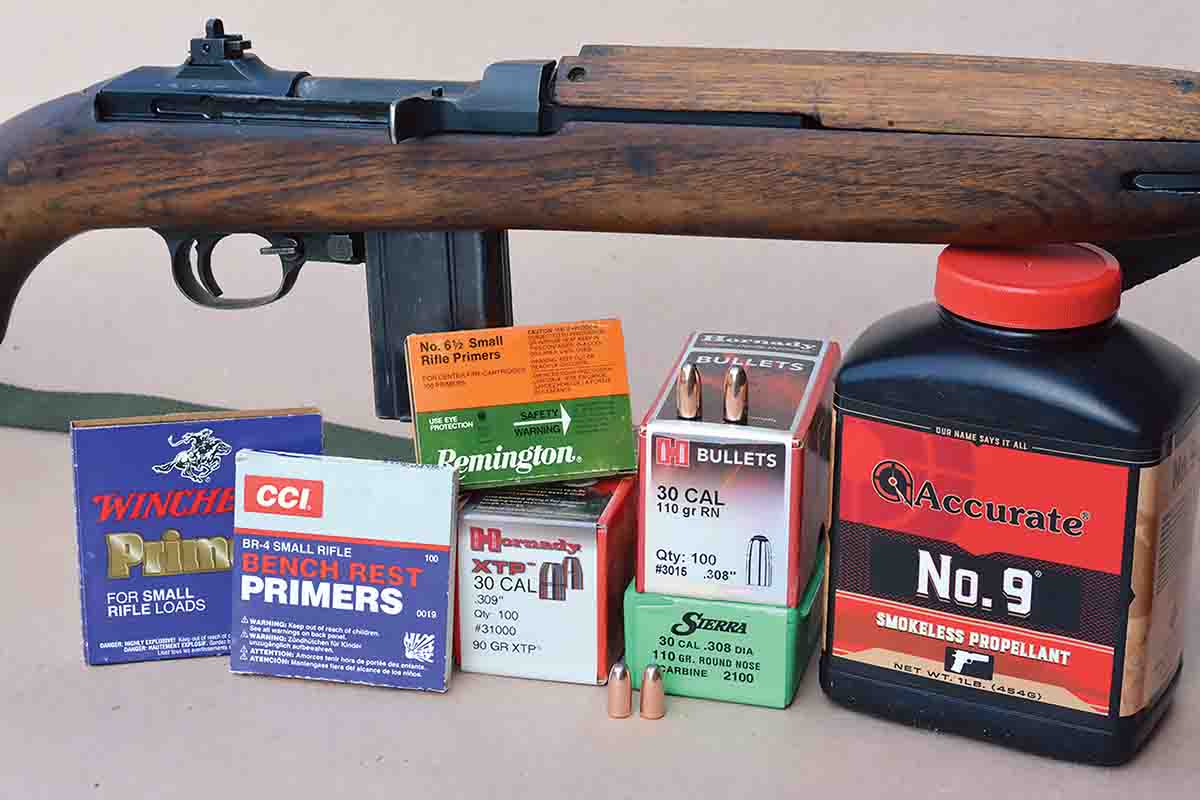
A good selection of bullets and powders is available for handloading the 30 Carbine.
Having owned and fired many original M1 Carbines over the years, I will state that a rifle with a good bore that is reasonably fresh, along with a properly-bedded stock, can be capable of 3-inch groups at 100 yards and some rifles will do even better than that.
In testing the accompanying “Pet Loads” data, rifles were fired at 75-yard targets. This seemed to be a practical distance for the rifle and cartridge and the targets corresponded well with the service aperture sights. This is certainly within the distance that most sport shooting will take place.
The U.S. M1 Carbine and the 30 Carbine cartridge played an important role in U.S. history. Today, this combination is fun to shoot, but is still capable of serving for protection, hunting and plinking.
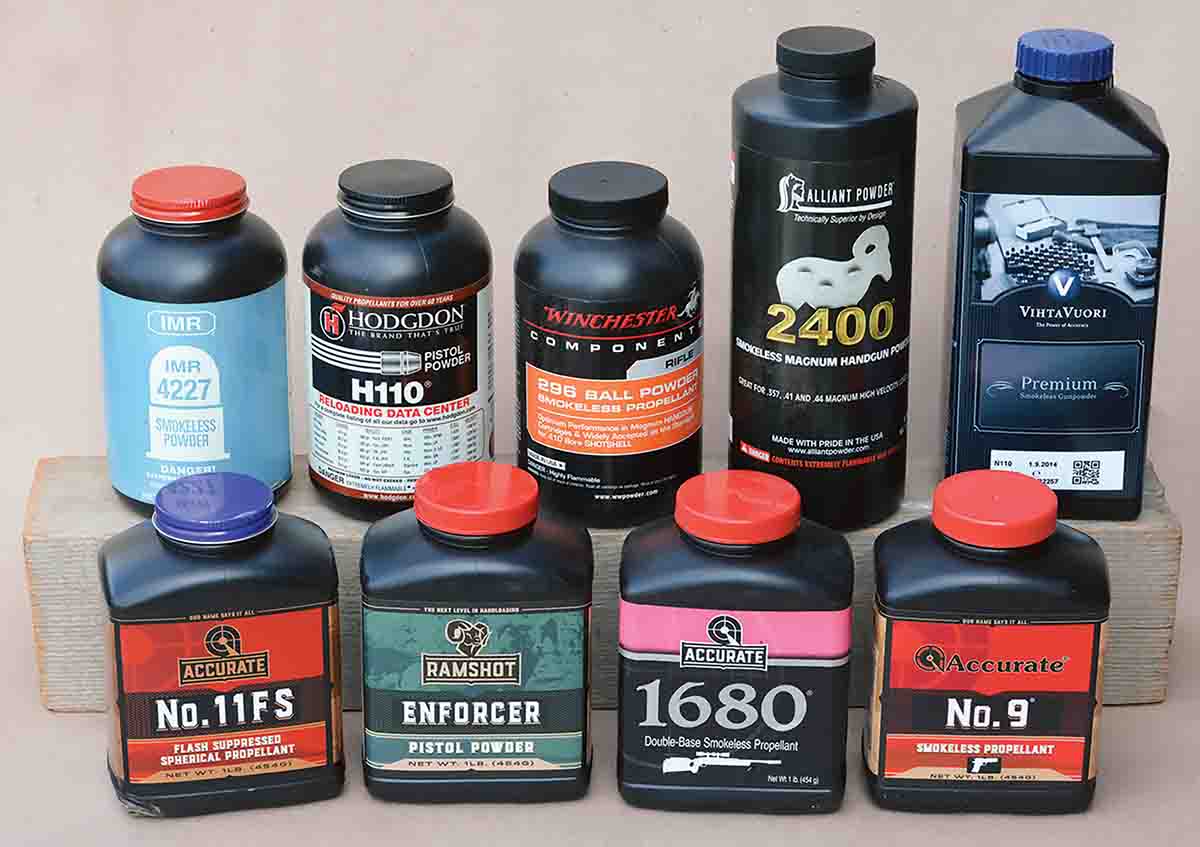
Powders that offer top performance in magnum revolver cartridges will give good results in the 30 Carbine.
















.jpg)
.jpg)
.jpg)
.jpg)


